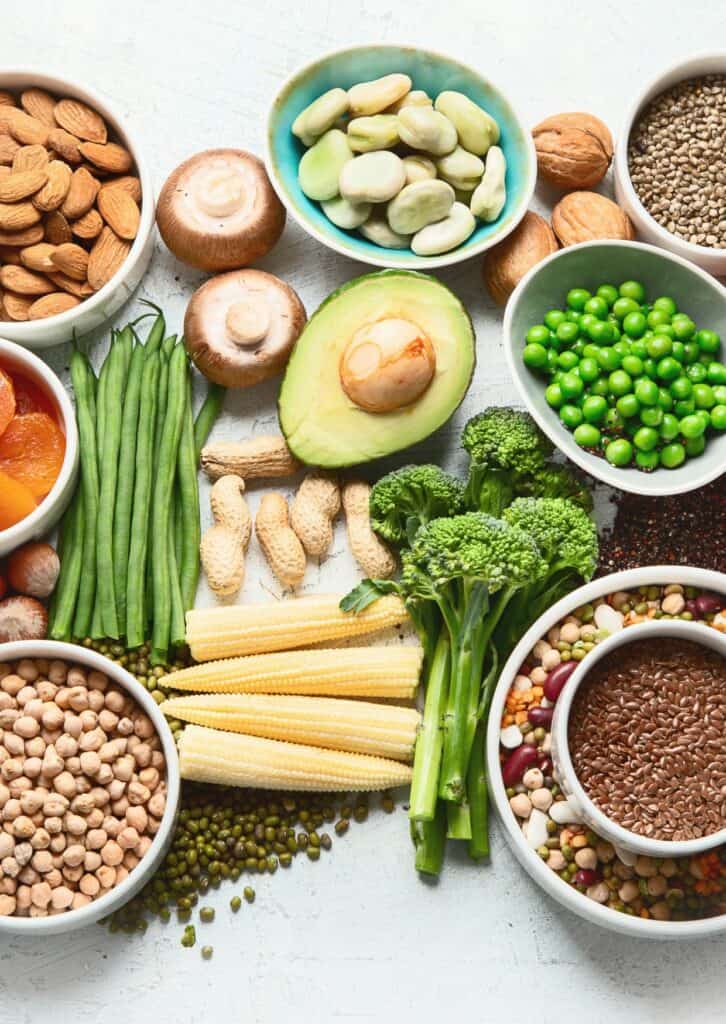SO KOMMT EINE FLEXITARIERIN AUF DIE 30 GRAMM
1. Frühstück
Cashew-Haselnuss-Avocado-Salat mit Rührei (ca. 9 g Ballaststoffe)
Das Frühstück besteht aus einem Viertel des Salats und einem Rührei, das in Kombination einen ballaststoffreichen Start in den Tag bietet. Hier ist die Berechnung:
•10 g Cashews: ca. 1 g Ballaststoffe
•10 g Haselnüsse: ca. 1 g Ballaststoffe
•0,5 TL Sonnenblumenkerne: ca. 0.5 g Ballaststoffe
•0,5 TL weißer Sesam: ca. 0.5 g Ballaststoffe
•0,5 TL schwarzer Sesam: ca. 0.5 g Ballaststoffe
•1 reife Avocado (ca. 100 g): ca. 7 g Ballaststoffe
•25 g Linsensprossen: ca. 1 g Ballaststoffe
2. Mittagessen
Thunfisch-Salat (halbes Rezept, ca. 7 g Ballaststoffe)
Der Thunfisch-Salat enthält ballaststoffreiche Zutaten, vor allem durch das Blattgemüse, den Sellerie und die Zwiebeln.
•1 rote Zwiebel: ca. 1.5 g Ballaststoffe
•2 Stangen Sellerie: ca. 1 g Ballaststoffe
•1/4 Kopf Romana- oder Eichblattsalat: ca. 1 g Ballaststoffe
•50 g Blattgrün (z. B. Spinat, Rucola): ca. 1 g Ballaststoffe
•1 Bio-Zitrone, Abrieb und Saft: ca. 0.5 g Ballaststoffe
•4 EL Kapern: ca. 1 g Ballaststoffe
•2 EL vegane Mayonnaise auf Rapsölbasis: ca. 1 g Ballaststoffe
3. Dessert
10 g dunkle Schokolade mit 85 % Kakao. Diese enthalten etwa 1,5 g Ballaststoffe.
Dunkle Schokolade mit einem hohen Kakaoanteil ist eine kleine, aber überraschende Ballaststoffquelle, wobei der genaue Ballaststoffgehalt je nach Marke und Herstellungsprozess leicht variieren kann.
4. Abendessen
Wunderbrot mit Kimchi, Butter und Lachs (ca. 15 g Ballaststoffe)
Das Wunderbrot ist besonders ballaststoffreich und in Kombination mit Kimchi eine gute Wahl.
•2 Scheiben Wunderbrot: ca. 8 g Ballaststoffe
•1 Portion Kimchi (ca. 50 g): ca. 2 g Ballaststoffe
•100 g Lachs oder Hühnerbrust: kein signifikanter Ballaststoffgehalt, liefert aber Proteine und Omega-3-Fettsäuren
•1 mittelgroße Karotte: ca. 2 g Ballaststoffe
•2 EL Hummus: ca. 3 g Ballaststoffe
Gesamt
31,5 Gramm Ballaststoffe
SO KOMMT EINE VEGanerin AUF DIE 30 GRAMM
1. Frühstück
Getreidefreies Porridge mit Samen, Kernen und Beeren (ca. 15 g Ballaststoffe)
Dieses Frühstück besteht aus vielen ballaststoffreichen Zutaten. Die Ballaststoffe verteilen sich in etwa wie folgt:
•2 EL geschrotete Leinsamen: ca. 4 g Ballaststoffe
•2 EL ungeschälte Mandeln: ca. 3 g Ballaststoffe
•1 EL Sonnenblumen- oder Kürbiskerne: ca. 1.5 g Ballaststoffe
•1 – 2 EL Chiasamen: ca. 5 g Ballaststoffe (bei 2 EL)
•2 EL Hanfsamen: ca. 1 g Ballaststoffe
•70 g Sauerkirschen oder Blaubeeren: ca. 0.5–1 g Ballaststoffe (je nach Art)
2. Mittagessen
Ribollita mit Gemüse und Bohnen (ca. 10 g Ballaststoffe)
Dieses Suppenrezept ist eine hervorragende Ballaststoffquelle, insbesondere durch die Bohnen und das Gemüse. Die Ballaststoffe verteilen sich etwa wie folgt:
•1 rote Zwiebel (¼ davon): ca. 0.5 g Ballaststoffe
•1 Karotte (¼ davon): ca. 0.7 g Ballaststoffe
•100 g Kartoffeln (¼ davon): ca. 1.5 g Ballaststoffe
•250 g Fenchel (¼ davon): ca. 1.5 g Ballaststoffe
•300 g Schwarzkohl (¼ davon): ca. 2 g Ballaststoffe
•400 g Tomaten (¼ davon): ca. 1.5 g Ballaststoffe
•300 g weiße Bohnen: ca. 6 g Ballaststoffe (bei 75 g, also ¼ der Menge)
Gesamt für die Suppe (¼ des Rezepts): ca. 10 g Ballaststoffe
3. Dessert
10 g dunkle Schokolade mit 85 % Kakao. Diese enthalten etwa 1,5 g Ballaststoffe.
Dunkle Schokolade mit einem hohen Kakaoanteil ist eine kleine, aber überraschende Ballaststoffquelle, wobei der genaue Ballaststoffgehalt je nach Marke und Herstellungsprozess leicht variieren kann.
4. Abendessen
Für das Abendessen verwende ich das Viertel des Alles-Grün-Salats mit Dressing, dazu zwei Scheiben Vollkornroggenbrot Sauerteigbrot und eine Portion Sauerkraut (ca. 10 g Ballaststoffe):
•1/4 Weißkohlkopf (ca. 100 g): ca. 2 g Ballaststoffe
•1 Minigurke (ca. 50 g): ca. 0.5 g Ballaststoffe
•1/4 Tasse Schnittlauch und Petersilie: ca. 0.5 g Ballaststoffe
•1 Portion Dressing mit Basilikum, Spinat und Nüssen: ca. 1 g Ballaststoffe
•2 Scheiben Roggenvollkornsauerteigbrot: ca. 4 g Ballaststoffe
•50 g Sauerkraut: ca. 2 g Ballaststoffe
Gesamt
36,5 Gramm Ballaststoffe
Weiterführende Informationen
ARTIKEL: So geht gesunde Ernährung in den Wechseljahren
PODCAST: Antientzündliche Ernährung im Meno-an-Mich Podcast
VIDEO: Die perfekte Mahlzeit für einen ausgeglichenen Blutzuckerspiegel








2 Antworten
Liebe Susanne,
ich verfolge deine Infos sehr gerne. Mich interessiert es persönlich und beruflich.
Ich bin Apothenkenhelferin, Kosmetikerin, Visagistin, Farb- und Stilberaterin und HP-Psych. Diese Kombi nutze ich um Frauen ganz individuell zum Thema Wechseljahren zu beraten. Jede Frau hat in dieser Phase Fragen, die vielleicht nicht die Gynäkologie oder Pharmazie betreffen. Ich hole genau dort Frauen ab, die innen in Balance und von außen schön sein wollen.
Mit meinem Fachwissen habe ich einen anderen Blick und ganzheitlichen Ansatz bzgl. Optik und Stimmung. Denn es reicht oft nicht ein Wohlfühlen über Medis hinzubekommen, wenn der Blick in den Spiegel unzufrieden macht. Mich freut es immer sehr, wenn die Frauen happy sind und ein Licht am Ende des Tunnels sehen.
Deine Gerichte kann ich leider oft nicht kochen, da mich sowohl eine Fructose- und Sorbitintolleranz plagt. Aber manchmal ersetze ich eine Gemüsesorte und dann passt es auch für mich.
Ich wünsche mir, dass noch viele Frauen aktiv werden und die Wechseljahren nicht als Quälerei empfinden.
Dann hab einen guten Start ins neue Jahr. Ich freue mich von dir zu lesen.
Liebe Grüße aus Bückeburg
Stephanie Frank
Liebe Stephanie,
vielen Dank für deine nette Nachricht aus Bückeburg! Wie inspirierend, dass du einen guten Weg gefunden hast, mit den Wechseljahren umzugehen. Ich verstehe sehr gut, dass die Fructose- und Sorbitintoleranz eine zusätzliche Herausforderung bei der Ernährungsumstellung darstellt. Es ist toll, dass du die Gerichte durch geschicktes Ersetzen von Zutaten an deine Bedürfnisse anpasst.
Liebe Grüße
Susanne